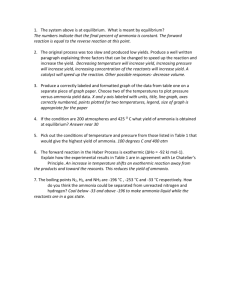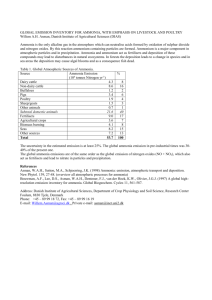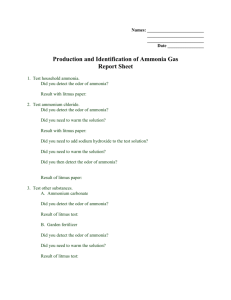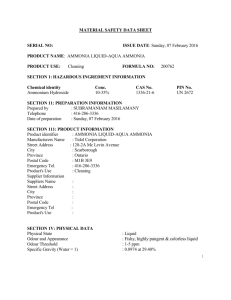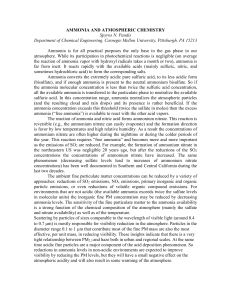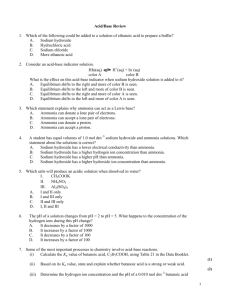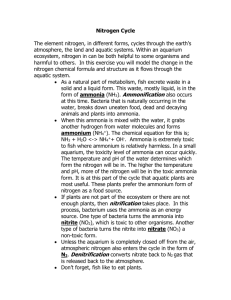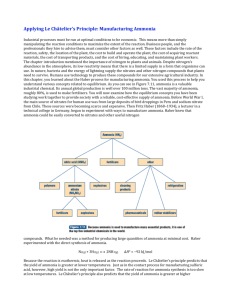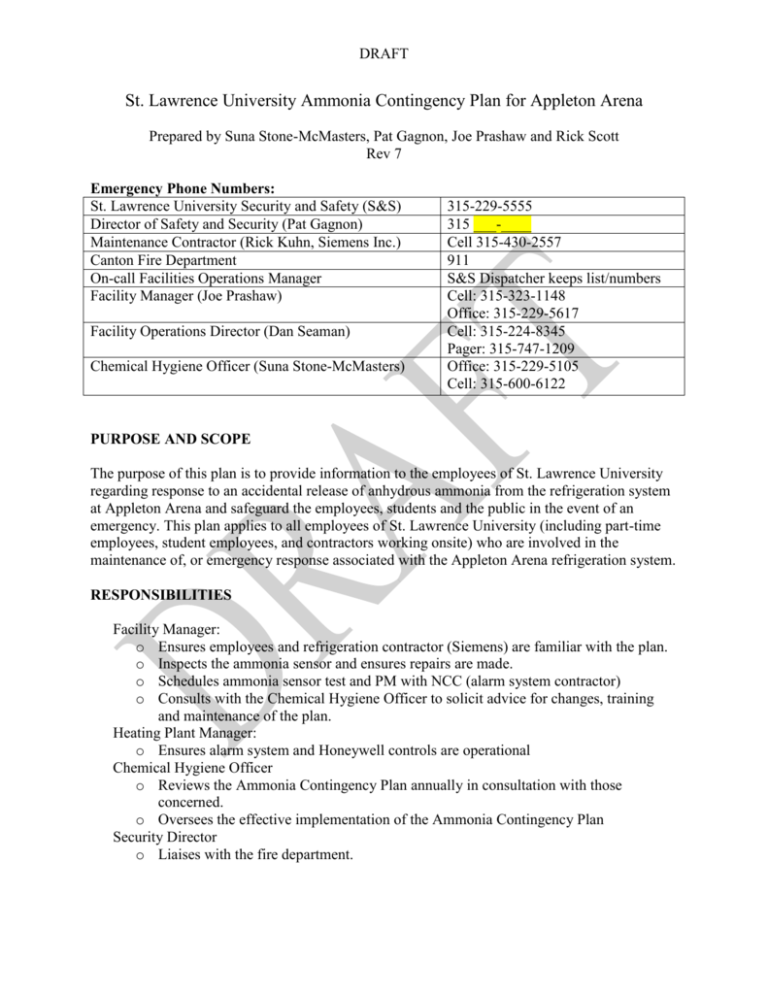
DRAFT
St. Lawrence University Ammonia Contingency Plan for Appleton Arena
Prepared by Suna Stone-McMasters, Pat Gagnon, Joe Prashaw and Rick Scott
Rev 7
Emergency Phone Numbers:
St. Lawrence University Security and Safety (S&S)
Director of Safety and Security (Pat Gagnon)
Maintenance Contractor (Rick Kuhn, Siemens Inc.)
Canton Fire Department
On-call Facilities Operations Manager
Facility Manager (Joe Prashaw)
Facility Operations Director (Dan Seaman)
Chemical Hygiene Officer (Suna Stone-McMasters)
315-229-5555
315 ___-____
Cell 315-430-2557
911
S&S Dispatcher keeps list/numbers
Cell: 315-323-1148
Office: 315-229-5617
Cell: 315-224-8345
Pager: 315-747-1209
Office: 315-229-5105
Cell: 315-600-6122
PURPOSE AND SCOPE
The purpose of this plan is to provide information to the employees of St. Lawrence University
regarding response to an accidental release of anhydrous ammonia from the refrigeration system
at Appleton Arena and safeguard the employees, students and the public in the event of an
emergency. This plan applies to all employees of St. Lawrence University (including part-time
employees, student employees, and contractors working onsite) who are involved in the
maintenance of, or emergency response associated with the Appleton Arena refrigeration system.
RESPONSIBILITIES
Facility Manager:
o Ensures employees and refrigeration contractor (Siemens) are familiar with the plan.
o Inspects the ammonia sensor and ensures repairs are made.
o Schedules ammonia sensor test and PM with NCC (alarm system contractor)
o Consults with the Chemical Hygiene Officer to solicit advice for changes, training
and maintenance of the plan.
Heating Plant Manager:
o Ensures alarm system and Honeywell controls are operational
Chemical Hygiene Officer
o Reviews the Ammonia Contingency Plan annually in consultation with those
concerned.
o Oversees the effective implementation of the Ammonia Contingency Plan
Security Director
o Liaises with the fire department.
DRAFT
GENERAL
The ice rink is open between August 20 and March 20. The ammonia system is located in the
compressor room in Appleton Arena which is accessed from the north parking lot through the
large overhead door or through the interior hallway. The refrigerant system has two compressor
units, which are regularly maintained. It contains 300 lbs. of anhydrous ammonia (NH3). Three
additional cylinders holding a total of 300 pounds of anhydrous ammonia are also stored in the
compressor room. Drawings of Appleton Arena with refrigeration system layout are in
Appendix A.
AMMONIA ALARM SYSTEM
The compressor room is equipped with a gas sensor for detection of ammonia leaks which is
mounted on the electrical panel to the right of the compressors.
The system alarm works as follows:
1- The alarm will activate an audible and strobe alarm by the compressor room overhead door
when the ammonia concentration reaches 75 ppm. This alarm is a warning to evacuate Appleton
Arena. In addition, the alarm will report to the Security Office via an autodialer, access control
system and the fire alarm panel. Employees may not enter the compressor room once the
alarm has been activated.
If an ammonia smell is detected outside Appleton Arena, emergency phones located in the
Appleton office at the opposite end of the building, can be used to inform Safety and Security
(x5555)
If the alarm system malfunctions the facility manager will take immediate steps to return it to
service and advise Safety & Security, EH&S and all Appleton staff that the system is out of
service.
RESPONSE
Upon activation of the alarm, the Safety & Security dispatcher is alerted and will in turn
immediately contact the County dispatcher at 911 and send a patrol officer to the scene to assist
as directed. Safety & Security will dispatch the Maintenance Contractor and the Facility
Manager. They will next contact the Director of Facilities Operations. Selected SLU staff (per
the Facilities Management Call-In Protocol) will also be notified by the dispatcher as soon as
possible after the response has been initiated.
All building occupants will evacuate the space regardless of any event in progress. The Incident
Commander (or their designee) will be in charge of the response and direct any evacuation of the
building and outside area. Emergency evacuation routes are posted throughout the building.
Security and Facilities staff working in the arena shall remain available to assist in directing the
DRAFT
evacuation by posting themselves at the exits of the building. Staff not on duty may be called in
to assist in the event of a serious emergency.
An emergency ammonia release valve and refrigeration equipment power shut-off switch are
located in a locked red box mounted 8 feet up on the west wall, adjacent to the exterior
Compressor room door. (See photo in Appendix A.) In case of an emergency, Canton Fire &
Rescue or the St. Lawrence County Hazmat Team will open the valve and shut down the system.
An event such as a major fire near the compressor room or a large discharge from the ammonia
refrigeration system poses a health hazard to people in the vicinity. The Incident Commander,
most likely the Canton Fire Chief, would decide on the need to activate the Village of Canton
Disaster Plan for an evacuation and activate the ammonia release valve. The map provided in
Appendix D delineates an isolation zone of 200 ft in all directions and an evacuation zone of
zone of 0.4 miles (DAY) or 1.4 miles (NIGHT) to safeguard people who could be affected from
a discharge from the ammonia refrigeration system.
COMPRESSOR SHUTDOWN
There are three (3) emergency shutdown switches for the system:
- In the compressor room; (see appendix B)
- Inside the emergency control box in the interior corridor, to the right of the compressor room
door; (see Appendix C)
- The Central Heating Plant
There are also four (4) yellow ammonia isolation valves located in the compressor room. See
Appendix B for a photo of these valves. A wrench for closing the valves is kept chained in reach
of the valves.
If the alarm sounds, any individual wearing proper PPE and trained to do so may shut down the
system.
NRC NOTIFICATION
The CERCLA (Comprehensive Environmental Response, Compensation, and Liability Act)
designated ammonia as a hazardous substance. The Reportable Quantity (RQ) is 100 lb. (45.4
kg). The Facility Manager, Director of Facilities Operations or Chemical Hygiene Officer is
required to notify the National Response Center (NRC) immediately when there is a release in an
amount equal to or greater than the RQ. Toll free (800) 424-8802.
REGULAR INSPECTIONS AND MAINTENANCE ACTIVITIES
From August 20th to March 20th the ice rink is open. The Facility Manager conducts daily visual
inspections of the ammonia compressor room, and completes a daily record report kept in this
DRAFT
room. After March 20th when the rink is closed, a technician from Siemans closes the valves.
Gas pressure in the compressors is continuously monitored in the heating plant year-round.
The ammonia sensor must be tested per Honeywell’s recommendations with certified calibration
gas every six months or after major exposure to a leak. See instructions and PM schedule in
Appendix E.
Conduct a response test once between calibrations, i.e. at three month intervals. Expose sensor to
ammonia/water solution to verify proper sensor response and alarm functions.
Employee Training and Exercises.
Any employee who may be involved in the maintenance of, or an emergency response associated
with, the refrigeration system must be trained and qualified for their responsibilities. These
employees include Grounds, Security, Skilled Trades, or other Facilities Management personnel,
and supervisors of those employees. New employees whose job requires them to work in the
arena shall be trained by their supervisor within one week of their arrival.
Trained employees shall undergo a brief annual refresher conducted and documented by the EHS
Manager to review the response plan and assess any changes noted in the course of the year. If
there are significant changes in the system, alarms or emergency response procedures, updated
training for all involved personnel will be conducted at the time of the changes.
In addition, certificates of training for Siemens contract employees, and an updated copy of their
contractual service agreement, are kept on file by Facilities Management.
NATURE AND HAZARDS OF AMMONIA
Ammonia (NH3) is a colorless gas, with a penetrating, pungent, and suffocating odor. It easily
dissolves in water to form a caustic solution called ammonium hydroxide (NH4OH), sometimes
referred to as aqueous ammonia. Ammonia has a vapor density less than air and will rise when
released, but it will readily react with moisture in the air, become heavier and sink to the ground
The table below describes some chemical characteristics of ammonia and ammonium hydroxide.
PHYSICAL CHEMICAL
PROPERTIES
Odor Threshold
pH
Vapour density
Colour and odor
Physical state
*TWA-TLV:
*STEL:
*IDLH:
*UEL:
*LEL:
AMMONIA
AQUEOUS AMMONIA
1-15 ppm
11.6
0.5967 of air density (air=1)
colorless pungent odor
gas
25 ppm
35 ppm
300 ppm
25% in air
16% in air
2-50 ppm
14
n/a
very pungent, choking
liquid
25 ppm
35 ppm
300 ppm
n/a
n/a
DRAFT
See acronymns, final page
RISKS
Inhalation of corrosive ammonia gas can cause irritation and inflammation of the respiratory
system, difficulty breathing, nausea, vomiting and chest pain. Irritation or burns may occur after
direct skin contact with anhydrous ammonia, solutions or concentrated ammonia gas. Direct
contact with ammonia with eyes may cause irritation, tearing, severe injury or blindness.
FIRST AID MEASURES
WHAT TO DO:
IN CASE OF
Ammonia (ammonium
hydroxide) on skin or in eyes
FIRST ACTION
SECOND ACTION
Immediately flush skin or eyes Bring victim to a physician.
with running water for at least
20 minutes. Occasionally lift
upper and lower lids of eyes.
Get victim into fresh air.
Bring victim to a physician.
Strong Ammonia fumes
inhaled
Refer to the Safety Data Sheet for anhydrous ammonia in Appendix E for further details.
An emergency shower and eye wash station is located in the Zamboni Room.
Any person from the University who requires medical assistance during the emergency must
follow up with the Risk Manager (Theresa Simoni, 229-5913) for further assessment and ensure
proper documentation of the event. The Incident Response Report must be filled out by the
employee’s supervisor (http://www.stlawu.edu/sites/default/files/resource/incident_report.pdf).
ACRONYMNS
TLV-TWA (Threshold Limit Value-Time Weighted Average): the concentration for a normal 8
hour workday and a 40 hour work week, to which nearly all workers may be repeatedly exposed,
day after day, without adverse effect.
STEL (Short Term Exposure Limit): the maximum concentration to which someone can safely
be exposed for a period of up to 15 minutes - with a maximum of four periods per day.
IDLH (Immediately Dangerous to Life and Health): concentrations which upon exposure are
likely to result in death or immediate or delayed permanent adverse health effects.
UEL (Upper Explosion Limit): the highest concentration of a vapor or gas which will explode,
ignite or burn in the presence of an ignition source. Mixtures above this limit are too rich to burn.
LEL (Lower Explosion Limit): the lowest concentration of a vapor or gas which will explode,
ignite or burn in the presence of an ignition source. Mixtures below this limit are too rich to burn.
MAINTENANCE OF THE AMMONIA CONTINGENCY PLAN
DRAFT
A review of the Ammonia Contingency Plan will be conducted annually to ensure contents are
current. A written copy of the Ammonia Contingency Plan is in the Department of Security and
Safety (76 Park St). It is electronically located on St. Lawrence University’s Environmental
Health and Safety web page (http://www.stlawu.edu/environmental-health-andsafety/environmental-health-and-safety-policies)
DRAFT
Appendix A – Appleton Arena Layout Drawing
Ammonia
vent
Compressor
room
Emergency
ammonia release
valve
Compressor
room door
Fresh air intake
Zamboni room
door
DRAFT
Appendiz B - Compressor shutoff (or is it ammonia isolation?) valves marked yellow.
Vent and fan
Ammonia sensor
Shutoff valves
Main shutoff
DRAFT
Appendix C –interior control panel with shutoff switches. To shut off, flip switches (UP?
DOWN?)
DRAFT
Appendix D – Evacuation Map of Campus and Canton
DRAFT
Appendix D cont.
DRAFT
Appendix E – Anhydrous Ammonia Safety Data Sheet
DRAFT
Appendix F: Maintenance of ammonia sensors and alarm system
Preventative Maintenance will be performed as follows:
Honeywell ammonia sensor tested and calibrated with certified calibration gas, per
manufacture’s recommendations, every 6 months by outside contractor NCC. Documentation
will be provided to Facility Manager and EHS and maintained for no less than 3 years.
Honeywell ammonia sensor response test once between each calibration (3 months after each
calibration) performed by facility manager. Documentation in form of a checklist to be kept on
site for a minimum of three years.
Alarm system to be tested in accordance with New York State Fire Code by outside contractor
NCC. Documentation provided to EHS and maintained for a minimum of three years.
Ventilation fan to be tested in accordance with New York State Fire Code by outside contractor
NCC. Documentation provided to EHS and maintained for a minimum of three years.
Gas pressure sensor operation will be verified by the heating plant every 3 months (I don’t know
how often this should be done or how you can test it. Rick, any suggestions?)
Maintenance
For proper operation of the Honeywell ammonia meter it is essential that the test and calibration schedule be
followed. Honeywell Analytics recommends the following maintenance schedule:
• Calibration should be performed with certified calibration gas every six months or after major exposure to a
leak. Calibration kits are available from Honeywell Analytics.
• Response test once between calibrations, i.e. at three month intervals. Expose sensor to ammonia/water
solution to verify proper sensor response and alarm functions. Test more frequently in highly critical
applications. The response test is not required if multiple electro-chemical sensors are installed in the
same room.
All tests and calibrations must be logged.
Sensor Life: These electrochemical cells are extremely reliable, but several things can cause the cell
chemicals to become depleted including:
• a period of time,
• exposure to high temperatures,
• exposure to varying concentrations of the target gas,
• exposure to high moisture for extended periods without proper sensor enclosure.
CAUTION Although SensorCheck tests the sensor’s electrical viability every 24 hours, it is
TM
absolutely essential that these units be exercised with a gas sample on a regular and timely basis.
Typical sensor life in a refrigerated area will be three to four years. Typical life in a non-refrigerated area will be
one and a half to two years. Exposure to high levels of ammonia will shorten these times. In addition to timely
response checks, a preventative maintenance program of periodic cell replacement should be implemented.
When the cell becomes depleted, a replacement cell can be obtained from Honeywell Analytics. Simply unplug
the ribbon cable from the pins labeled Sensor, pull the old cell from the spring clip, discard the old cell and
replace it with a new one.
DRAFT
The sensor should be checked according to the following procedure after a five-minute warm-up period. Manning
EC-F9-NH3 Sensor 19546 ECF9NH3 07/09 REVE Copyright © 2009 Honeywell Analytics. All Rights Reserved. 19
http://www.instrumart.com/assets/Honeywell-Manning-EC-F9-NH3-manual.pdf
The Macurco low-level ammonia detector procured through NCC requires replacement of the
sensor every 2 years. Calibration is not required, as the unit uses on-board diagnostics. For
instructions see:
http://www.aerionics.info/files/Macurco_TX-6-AM_Manual_4-8-20132.pdf
DRAFT
Short Version Ammonia Response
*If the alarm goes off:
Security will receive autodial message and request HazMat response via 911.
Security will call Joe Prashaw, Dan Seaman, Suna Stone-McMasters and Siemens Technician
Evacuate Compressor Room.
Room will be vented automatically via ceiling fan unit, gas will discharge out roof.
If safe to do so, shut off compressors from heating plant or panel in interior hallway.
Begin evacuation of Appleton Arena.
*If ammonia escapes from compressor room (alarm sounds and odor
is present outside)
Check wind direction.
Evacuate Appleton Arena, guide evacuees upwind/away from ammonia plume, to safe zone 200
feet in diameter from compressor room.
Provide first aid to any person exposed to ammonia.
DRAFT
Appendix G – Weekly ammonia sensor check
Week of:
Date and
time checked
Initials of
person
checking*
Both Sensors in
service? Y/N
NCC and Safety & Security
contacted if sensor not in
service?
Y/N/NA
*JP=Joe Prashaw, ______________________________ Send completed form to EHS when
complete. Mail to: EH&S Office, Warehouse. 229-5913
DRAFT
Appendix H – Semi-Annual ammonia sensor test (using calibration gas)
Calibration/test Due April 30
Date and time checked
Name of person
checking*
Calibration gas expiration date,
Calibration gas expiration date
Manning calibration gas 1000 ppm Ammonia gas in air
Macurco AM-FCK: Gas Cylinder, 25 ppm Ammonia gas in air
Both Sensors in service?
Y/N
Readout at alarm:
LCD-NH3 sensor:
Manning EC-F9-
Readout at alarm: Macurco
TX-6-AM Sensor:
NCC and Safety &
Security contacted if
sensor not in service?
Y/N/NA
Alarm and strobes operate? Y/N
Signal received at Safety &
Security? Y/N
NCC and Safety &
Security contacted if
alarms/strobes/signal fail?
Y/N/NA
Calibration/test Due October 31
Date and time checked
Name of person
checking*
Calibration gas expiration date,
Calibration gas expiration date
Manning calibration gas 1000 ppm Ammonia gas in air
Macurco AM-FCK: Gas Cylinder, 25 ppm Ammonia gas in air
Both Sensors in service?
Y/N
Readout at alarm:
LCD-NH3 sensor:
Manning EC-F9-
Readout at alarm: Macurco
TX-6-AM Sensor:
NCC and Safety &
Security contacted if
sensor not in service?
Y/N/NA
Alarm and strobes operate? Y/N
Signal received at Safety &
Security? Y/N
NCC and Safety &
Security contacted if
alarms/strobes/signal fail?
Y/N/NA
*NCC representative.
Send completed form to EHS when complete. Mail to: EH&S Office,
Warehouse. 229-5913. Send NCC April report to same address.


